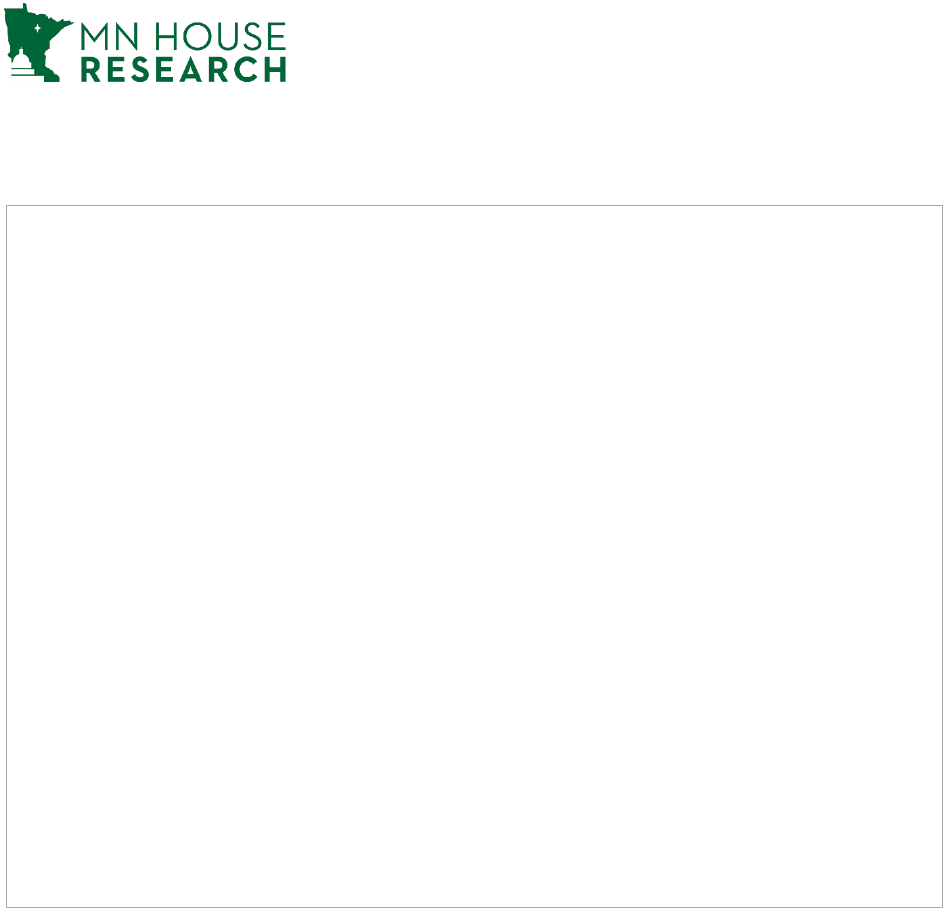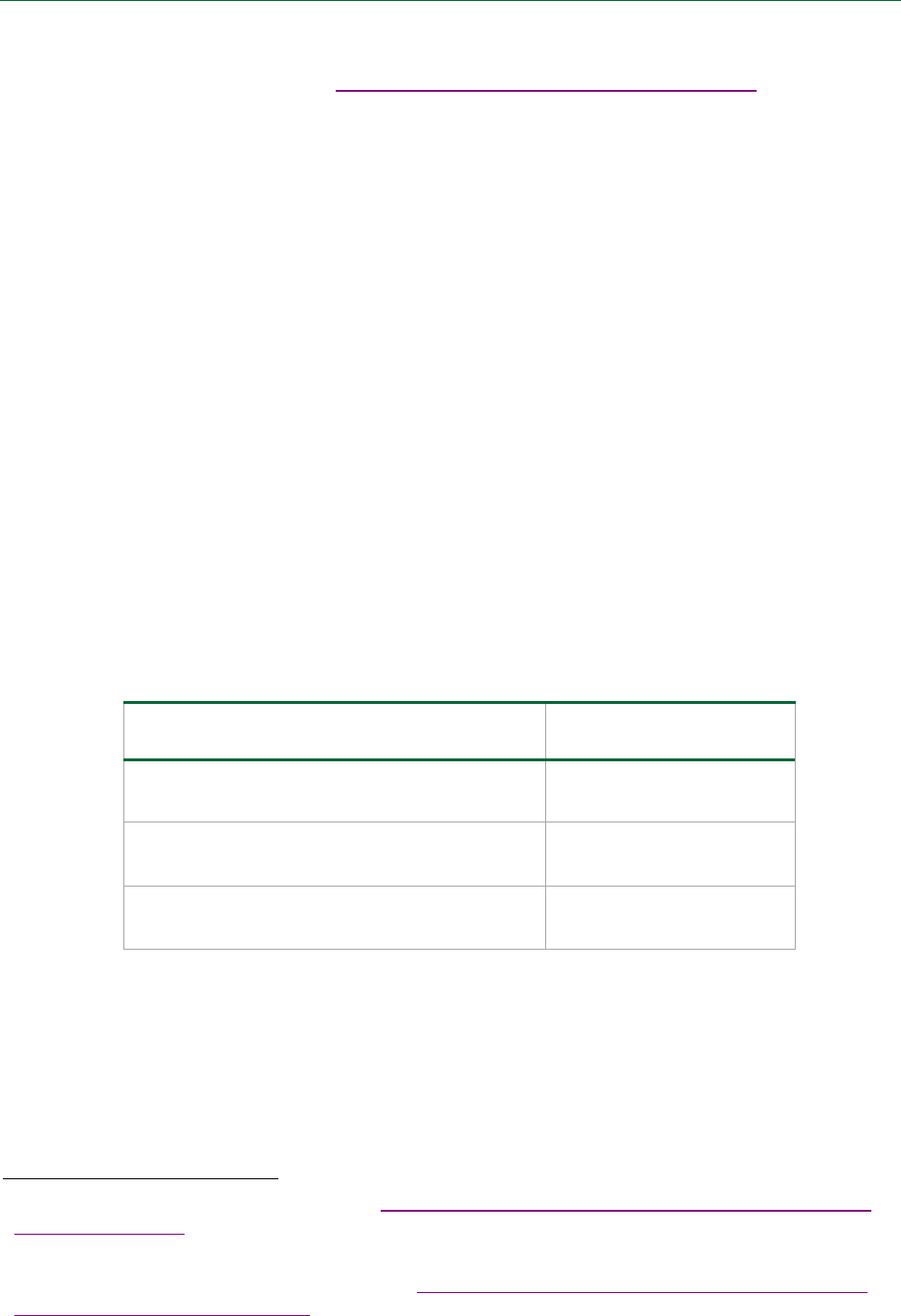
By Danyell A. Punelli, 651-296-5058
Long-Term Care
Workforce Incentives
April 2024
Executive Summary
The state of Minnesota has experienced a workforce shortage in the area of long-term care.
This shortage impacts the entire range of services from nursing facilities to home and
community-based care. This workforce shortage is occurring at a time when the number of
people over the age of 65 is growing.
In mid-2022, job vacancy rates for nursing assistants was 17.4 percent and for home health
and personal care aides, 8.3 percent, according to the Minnesota Department of
Employment and Economic Development (DEED).
The Minnesota Legislature has attempted to deal with this issue in recent years by:
creating incentive grant programs designed to increase the workforce;
increasing payment rates for home and community-based services in an effort to
raise wages for direct support professionals; and
instituting loan forgiveness and grant programs for health care personnel working in
underserved areas of the state or in certain long-term care settings.
This publication summarizes the various ways that have been established in law to address
the long-term care workforce shortage in Minnesota. It also includes an overview of the
current state of the long-term care workforce and demographic trends.
Contents
Factors Influencing the Workforce Shortage .......................................................... 2
Workforce Incentive Grant Programs ..................................................................... 4
Long-Term Services and Supports Workforce Incentive Grants ....................... 5
New American Legal, Social Services, and Long-Term Care Workforce Grant
Program .......................................................................................................... 6
Nursing Facility Workforce Incentive Grant Program ....................................... 7
Payment Rate Increases .......................................................................................... 7
Disability Waiver Rate System .......................................................................... 8
Personal Care Assistance and Community First Services and Supports ........... 9
Elderly Waiver ................................................................................................. 10
Other Home and Community-Based Services ................................................ 10

Long-Term Care Workforce Incentives
Minnesota House Research Department Page 2
Loan Forgiveness Programs .................................................................................. 11
Home and Community-Based Services Employee Scholarship Grant and Loan
Forgiveness Program ................................................................................... 11
Health Professional Education Loan Forgiveness Program ............................ 12
Factors Influencing the Workforce Shortage
The long-term care workforce shortage impacts the entire range of services from nursing
facilities to home and community-based care as these facilities and providers struggle to recruit
and retain direct support professionals to assist older adults, people with disabilities, and
people with mental health care needs. According to the Department of Human Services (DHS),
“the workforce crisis prevents access to services, can be a factor in abuse, neglect and injury
incidents, and contributes to people living in facilities.”
1
According to DEED, from 2020 to 2022, job vacancy rates for these jobs ranged from 5.2
percent to 23.2 percent, and median hourly wage offers ranged from $12.99 for a personal care
aide during the fourth quarter of 2020 to $16.83 for a nursing assistant during the second
quarter of 2022. Job vacancy rates as of the second quarter of 2022 were 8.3 percent for home
health aides and personal care aides, and 17.4 percent for nursing assistants.
The table below shows the number of job vacancies and median wage offers for home health
aides, personal care aides, and nursing assistants from 2020 to 2022.
Job Vacancy Rates and Median Wage Offers
for Certain Long-Term Care Occupations in Minnesota, 2020-2022
Quarter Occupation
No. of Job
Vacancies
Job Vacancy
Rate
Median Hourly
Wage Offer
2022 2nd Quarter
Home health aides
Personal care aides
9,067*
8.3%*
$15.46
$14.98
—
Nursing assistants
4,416
17.4%
$16.83
2021 4th Quarter
Home health aides
Personal care aides
9,110*
8.4%*
$14.96
$14.99
—
Nursing assistants
5,878
23.2%
$16.75
2021 2nd Quarter
Home health aides
Personal care aides
9,259*
9.0%*
$13.34
—
Nursing assistants
6,001
21.2%
$15.49
1
Department of Human Services website, https://mn.gov/dhs/partners-and-providers/news-initiatives-reports-
workgroups/long-term-services-and-supports/workforce/.

Long-Term Care Workforce Incentives
Minnesota House Research Department Page 3
Quarter Occupation
No. of Job
Vacancies
Job Vacancy
Rate
Median Hourly
Wage Offer
2020 4th Quarter
Home health aides
Personal care aides
5,383*
5.2%*
$14.43
$12.99
—
Nursing assistants
3,990
13.1%
$15.00
2020 2nd Quarter
Home health aides
Personal care aides
8,805*
8.5%*
$13.68
$13.36
—
Nursing assistants
2,755
9.1%
$15.01
* Data combined for home health aides and personal care aides
Source: Minnesota Employment and Economic Development, Job Vacancy Survey and Occupational Employment
and Wage Statistics data
Compounding the workforce shortage are demographic trends. As the following graph shows,
the percentage of the population age 65 and older has increased sharply from about 9.0
percent in 1950 to a projected high of about 19.6 percent in 2035 and then a plateau of around
19.0 percent thereafter.
Percent of Minnesota Population Age 65 or Older, 1950 to 2075
Note: Graph derived from House Research analysis of Census Bureau microdata obtained from IPUMS-
USA. Estimates from 1950 to 1990 used 1 percent national sample data; estimates from 2001 and later

Long-Term Care Workforce Incentives
Minnesota House Research Department Page 4
used American Community Survey national random sample data. Estimates for 2025 and later were
obtained from the February 2023 Minnesota State Demographer population projections
.
According to the Minnesota State Demographer, “Minnesotans of retirement age (65) and
above numbered 930,000 in 2020. This number is expected to roll over to 1.26 million by 2075.
Minnesota’s oldest residents—those aged 85 and above—are expected to rapidly increase…”
2
The U.S. Department of Health and Human Services longitudinal data shows that “70 percent of
adults who survive to age 65 develop severe [long-term services and supports] needs before
they die and 48 percent receive some paid care over their lifetime.”
3
Workforce Incentive Grant Programs
The Minnesota Legislature has recently created workforce incentive grant programs to address
the workforce shortage. These programs are described below and include the long-term
services and supports workforce incentive grants; new American legal, social services, and long-
term care workforce incentive grants; and the nursing facility workforce incentive grant
program. These programs are administered by the Department of Human Services.
The 2023 Legislature appropriated more than $193 million to three separate grant programs.
The following table shows the workforce incentive grant programs and the fiscal year 2024
appropriations for each program.
Workforce Incentive Grant Program Appropriations for FY 2024
Program FY 2024 Appropriation
Long-term services and supports workforce
incentive grants
$83,560,000
New American legal, social services, and long-
term care workforce incentive grant program
$35,316,000
Nursing facility workforce incentive grant
program
$74,500,000
Note: The appropriations for the long-term services and supports workforce incentive grants
and the nursing facility workforce incentive grant program are available until June 30, 2029. The
appropriation for the new American legal, social services, and long-term care workforce
incentive grant program is available until June 30, 2027.
2
Minnesota State Demographic Center website, https://mn.gov/admin/demography/data-by-topic/population-
data/our-projections/.
3
“What is the Lifetime Risk of Needing and Receiving Long-Term Services and Supports?” April 3, 2019, U.S.
Department of Health and Human Services website, https://aspe.hhs.gov/reports/what-lifetime-risk-needing-
receiving-long-term-services-supports.

Long-Term Care Workforce Incentives
Minnesota House Research Department Page 5
Long-Term Services and Supports Workforce Incentive Grants
The long-term services and supports workforce incentive grants were established in 2023 to
assist long-term services and supports providers with recruiting and retaining direct support
professionals.
4
Eligible grant recipients. Employers eligible to participate in the grant program include
organizations that are enrolled in a Minnesota health care program that are:
home and community-based services providers;
certified intermediate care facilities for persons with developmental disabilities;
nursing facilities;
personal care assistance services providers;
community first services and supports providers;
early intensive developmental and behavioral intervention services providers;
home care services providers;
certain financial management services providers; or
customized living services providers.
Allowable uses of grant funds. Grantees must use grant money to provide payments to eligible
workers for the following purposes:
retention, recruitment, and incentive payments
postsecondary loan and tuition payments
child care costs
transportation-related costs
personal care assistant background study costs
other costs associated with retaining and recruiting workers, as approved by the
commissioner
Eligible workers are workers who earn $30 per hour or less and are currently employed or
recruited to be employed by an eligible employer.
Grant awards are not considered income, assets, or personal property for purposes of
determining eligibility or recertifying eligibility for a variety of income assistance and health
care programs. In addition, grant awards are subtracted from a recipient’s income for tax
purposes.
Appropriations. In fiscal year 2024, $83,560,000 was appropriated for the long-term services
and supports workforce incentive grants. This appropriation is available until June 30, 2029, and
is a onetime appropriation.
4
Minn. Stat. § 256.4764.

Long-Term Care Workforce Incentives
Minnesota House Research Department Page 6
New American Legal, Social Services, and Long-Term Care
Workforce Grant Program
The new American legal, social services, and long-term care workforce grant program was
established in 2023 for organizations that serve and support new Americans: (1) in seeking or
maintaining legal or citizenship status to legally obtain or retain employment in any field or
industry; or (2) to provide specialized services and supports to new Americans to enter the
long-term care workforce.
5
A “new American” is defined as an individual born abroad and the
individual’s children, irrespective of immigration status.
Eligible grant recipients. Eligible grantees include governmental units, federally recognized
Tribal nations, nonprofit organizations, for-profit organizations, and legal services organizations
specializing in obtaining visas for health care workers. Eligible applicants seeking to provide
supports for new Americans to obtain or maintain employment must demonstrate expertise
and capacity to provide training, peer mentoring, supportive services, workforce development,
and other services to develop and implement strategies for recruiting and retaining qualified
employees.
Allowable uses of grant funds. Allowable uses of grant money include:
intake, assessment, referral, orientation, legal advice, or representation to new
Americans to seek or maintain legal or citizenship status and secure or maintain
legal authorization for employment;
social services designed to help eligible populations meet their immediate basic
needs during the process of seeking or maintaining legal status and legal
authorization for employment; or
specialized activities targeted to individuals to support recruitment and connection
to long-term care employment opportunities, including:
o developing connections to employment with long-term care employers and
potential employees;
o providing recruitment, training, guidance, mentorship, and other support
services necessary to encourage employment, employee retention, and
successful community integration;
o providing career education, wraparound support services, and job skills
training in high-demand health care and long-term care fields;
o paying for program expenses related to long-term care professions; or
o repaying student loan debt directly incurred as a result of pursuing a
qualifying course of study or training.
Appropriations. In fiscal year 2024, $35,316,000 was appropriated for the new American legal,
social services, and long-term care workforce grant program. This appropriation is available
until June 30, 2027, and is a onetime appropriation.
5
Laws 2023, ch. 61, art. 1, § 60.

Long-Term Care Workforce Incentives
Minnesota House Research Department Page 7
Nursing Facility Workforce Incentive Grant Program
The nursing facility workforce incentive grant program was established in 2023 to assist nursing
facilities with recruiting and retaining eligible workers.
6
Eligible grant recipients. An eligible worker is a worker who earns $30 per hour or less and is
currently employed or recruited to be employed by a nursing facility.
Allowable uses of grant funds. Nursing facilities must use grant money to provide payments to
eligible workers for the following purposes:
retention, recruitment, and incentive payments
employee-owned benefits, such as health savings accounts, HRSA, and flexible
spending accounts
employee contributions to a 401k account
education, professional development, and financial counseling
child care, meals, transportation, and housing
health and wellness
other flexible needs related to workforce challenges as determined by the
commissioner
Each eligible worker may receive payments of up to $3,000 per year from the workforce
incentive grant account and all other state money intended for the same purpose.
Grant awards are not considered income, assets, or personal property for purposes of
determining eligibility or recertifying eligibility for a variety of income assistance and health
care programs. In addition, grant awards are subtracted from a recipient’s income for tax
purposes.
Appropriations. In fiscal year 2024, $74,500,000 was appropriated for the nursing facility
workforce incentive grant program. This appropriation is available until June 30, 2029, and is a
onetime appropriation.
Payment Rate Increases
The legislature approved various payment rate increases for home and community-based
services in an effort to increase wages for direct support professionals, including payment rate
increases under the Disability Waiver Rate System (DWRS), personal care assistance (PCA) and
community first services and supports (CFSS) services, elderly waiver, and various other home
and community-based services. These programs are administered by the Department of Human
Services.
The programs described in this section are all part of Medical Assistance (MA), the state’s
Medicaid program. The federal government pays a share of the cost of MA expenditures. This is
6
Minn. Stat. § 256.4766.

Long-Term Care Workforce Incentives
Minnesota House Research Department Page 8
referred to as the federal medical assistance percentage (FMAP). Minnesota’s FMAP for
covered services is 51.49 percent. Minnesota pays the remaining 48.51 percent for most
services (some services have a county share).
7
Disability Waiver Rate System
The DWRS is Minnesota’s uniform, statewide methodology to determine reimbursement rates
for home and community-based services provided under the four Medicaid (MA) disability
waivers: the community alternative care (CAC) waiver, the community access for disability
inclusion (CADI) waiver, the developmental disability (DD) waiver, and the brain injury (BI)
waiver.
8
Effective January 1, 2024, the DWRS payment rate methodology was modified by increasing the
value of the competitive workforce factor for the following services:
1) community residential services
2) family residential services
3) integrated community supports
4) adult day services
5) day support services
6) prevocational services
7) unit-based services with programming
8) unit-based services without programming
The competitive workforce factor supports direct care worker compensation for workers that
provide services under the DWRS.
In addition, the DWRS was modified to require that certain providers with rates determined
under the DWRS use a specified minimum percentage of the revenue generated by the DWRS
rate framework for direct care staff compensation.
9
The minimum percentage that must be
used for direct care staff compensation varies by provider type from 45 percent to 66 percent.
Compensation includes items such as:
1) wages;
2) taxes and workers' compensation;
3) health, dental, vision, and life insurance;
4) short- and long-term disability insurance;
5) retirement spending;
7
For example, counties are responsible for 20 percent of the cost of nursing facility placements of persons with
disabilities under age 65 that exceed 90 days. For this and other required county shares, see Minnesota Statutes,
section 256B.19, subdivision 1.
8
Minn. Stat. § 256B.4914.
9
Minn. Stat. § 256B.4914, subd. 10d.

Long-Term Care Workforce Incentives
Minnesota House Research Department Page 9
6) tuition reimbursement;
7) wellness programs;
8) paid vacation time;
9) paid sick time; or
10) other items of monetary value provided to direct care staff.
These changes to the DWRS rate methodology were intended to increase wages for direct
support professionals who provide these services.
Personal Care Assistance and Community First Services and
Supports
Personal care assistants provide assistance and support to persons with disabilities, the elderly,
and others with special health care needs living independently in the community.
The CFSS program
10
was created by the 2013 Legislature and will replace the PCA program and
consumer support grants. CFSS will be available statewide to eligible individuals to provide
assistance and support to persons with disabilities, the elderly, and others with special health
care needs living independently in the community. CFSS will be phased in beginning in June
2024.
The PCA/CFSS payment rate methodology was modified in 2023 to update the base wage index,
modify the implementation components to have a greater percentage of the rates based on the
new payment methodology, and add a worker retention component. The changes to the base
wage index and implementation components are effective January 1, 2024, and the addition of
the worker retention component is effective January 1, 2025. In addition, a new contract was
ratified for self-directed workers, which includes personal care assistants working under the
direction of a participant or participant’s representative.
11
These changes are intended to
increase payment rates, and thereby wages, for personal care assistants and support workers.
The PCA and CFSS programs currently include a requirement that a minimum of 72.5 percent of
the revenue generated by Medical Assistance must be used for personal care assistant and
support worker wages and benefits for services provided under the PCA program and the CFSS
agency-provider model.
12
The new contract that was ratified includes a minimum wage of $19 per hour for self-directed
workers as of January 1, 2024, and an additional increase to $20 per hour as of January 1, 2025.
10
Minn. Stat. § 256B.85.
11
Minn. Stat. § 256B.0711.
12
Minn. Stat. § 256B.0659, subds. 20 and 21, and § 256B.85, subds. 11 and 12.

Long-Term Care Workforce Incentives
Minnesota House Research Department Page 10
Elderly Waiver
The elderly waiver (EW) provides home and community-based services not normally covered
under MA to MA enrollees who are at risk of nursing facility placement. In addition, EW
recipients are eligible for all standard MA covered services.
The elderly waiver payment rate methodology was modified by: repealing the phase-in to the
new rate methodology (thereby basing rates entirely on the new rate methodology going
forward), changing the base wage index calculations for various services provided under the
elderly waiver, adjusting the values of various rate setting factors and establishing new rate
setting factors, establishing a floor for the elderly waiver adjusted base wage of $16.68, and
changing various component rate calculations. These changes are effective January 1, 2024, or
upon federal approval, whichever is later.
In addition, except for certain customized living services, the elderly waiver payment rate
methodology was modified to require at least 80 percent of the marginal increase in revenue
from implementing any elderly waiver rate adjustments to be used to increase compensation-
related costs for employees directly employed by the provider.
13
Compensation-related costs
include items such as:
1) wages and salaries;
2) the employer’s share of various taxes, workers' compensation, and mileage
reimbursement;
3) the employer's paid share of health and dental insurance, life insurance, disability
insurance, long-term care insurance, uniform allowance, pensions, and contributions to
employee retirement accounts; and
4) benefits that address direct support professional workforce needs above and beyond
what employees were offered prior to the implementation of any elderly waiver rate
adjustments.
All of the elderly waiver payment rate methodology changes were intended to increase direct
support professional compensation, with a floor set at $16.68 per hour.
Other Home and Community-Based Services
Several other home and community-based services will receive rate increases as a result of
legislation that was enacted in 2023.
14
The programs that will receive rate increases include
home care services, services provided under MA waivers that are not reimbursed through the
DWRS or elderly waiver payment rate methodologies, and certain services provided to
individuals who reside in intermediate care facilities for persons with developmental
disabilities.
13
Minn. Stat. § 256S.211, subd. 4.
14
Laws 2023, ch. 61, art. 1, §§ 68 and 71-73, and art. 2, § 40.

Long-Term Care Workforce Incentives
Minnesota House Research Department Page 11
Effective January 1, 2024, or upon federal approval, whichever is later, the following home and
community-based services will receive payment rate increases as indicated below:
home health agency services: 14.99 percent
home care nursing: 25 percent
chore services and home-delivered meals provided under the MA disability waivers:
14.99 percent
early intensive developmental and behavioral intervention benefit services: 14.99
percent
day training and habilitation services provided by intermediate care facilities for
persons with developmental disabilities: 14.99 percent
community living assistance and family caregiver services provided under the
alternative care, essential community supports, and elderly waiver programs: 14.99
percent
These rate changes were intended to increase wages for the direct support professionals who
provide these services.
Loan Forgiveness Programs
The Minnesota Department of Health (MDH) administers loan forgiveness and grant programs
to health care personnel working in underserved areas of the state or in certain health care
settings. Two of these programs are available to personnel working in long-term care settings:
the home and community-based services employee scholarship grant and loan forgiveness
program and the health professional education loan forgiveness program.
Home and Community-Based Services Employee Scholarship Grant
and Loan Forgiveness Program
The home and community-based services (HCBS) employee scholarship grant and loan
forgiveness program
15
has two components:
providing grants for scholarships and educational programming for HCBS workers;
and
providing loan forgiveness to HCBS workers nominated by their employers.
To be eligible for grants, and for their employees to be eligible for loan forgiveness and
scholarships, an HCBS provider must primarily provide services to individuals age 65 and older
in home and community-based settings and must be located in Minnesota.
Scholarships and educational programs. Under the scholarship program, the commissioner
provides grants to eligible HCBS providers. An HCBS provider that receives a grant must
establish an HCBS employee scholarship program and provide educational programs or award
15
Minn. Stat. § 144.1503.

Long-Term Care Workforce Incentives
Minnesota House Research Department Page 12
scholarships to employees who are enrolled in courses leading to career advancement with the
provider or in long-term care, and who work an average of at least ten hours per week for the
provider. The commissioner may also provide scholarships to individual HCBS workers who
meet these requirements.
An HCBS worker who receives a scholarship from their employer or from the commissioner
must use the money for the costs of a course of study leading to career advancement with the
provider or in long-term care, including home care, care of people with disabilities, nursing, or
as an assisted living director.
Loan forgiveness. To obtain loan forgiveness, an HCBS worker’s employer must submit
employee names to the commissioner, and those employees may apply to the commissioner.
When awarding grants, the commissioner must select employees based on their suitability for
practice and must give preference to employees close to completing their training. The
commissioner, in collaboration with HCBS stakeholders, may establish priority areas for loan
forgiveness if needed due to the volume of applications.
If an employee receives loan forgiveness, the employee must agree to work at least 32 hours
per week for at least two years for an eligible provider. Each year the employee maintains
eligibility, up to four years, the commissioner makes a payment to the employee of 15 percent
of the average educational debt for indebted graduates in their profession in the year closest to
the employee’s selection for the loan forgiveness program for which information is available.
Loan forgiveness payments must not exceed the balance of the employee’s educational loans.
Appropriations. $1,450,000 in fiscal year 2024 and $1,450,000 in fiscal year 2025 were
appropriated for this program.
At least two-thirds of the money appropriated for this program must be used for
employee scholarships. In fiscal year 2023, a total of $967,136.14 was awarded to 12
HCBS providers for employee scholarship programs.
Up to one-third of the money appropriated for this program may be used for loan
forgiveness. In fiscal year 2023, loan forgiveness awards were made to 32 employees
of 12 HCBS providers.
16
Health Professional Education Loan Forgiveness Program
Under the health professional education loan forgiveness program,
17
the commissioner awards
loan forgiveness to health professionals working in certain underserved areas or in certain
health care settings. This program is not targeted to professionals working in long-term care
settings. Some health professionals working in designated rural areas or, for some professions,
underserved urban communities may work in any setting, including a long-term care setting,
while receiving loan forgiveness under this program. However, some loan forgiveness for
nurses under this program is targeted to nurses who work in certain long-term care settings—a
16
https://www.health.state.mn.us/facilities/ruralhealth/funding/grants/docs/2023hcbsawards.pdf.
17
Minn. Stat. § 144.1501.

Long-Term Care Workforce Incentives
Minnesota House Research Department Page 13
nursing home, intermediate care facility for persons with developmental disabilities, or assisted
living facility—or for a home care provider.
18
To be eligible for loan forgiveness under this program, a health professional must agree to
practice in a location specified for that profession in statute and must commit to the service
obligation for that profession in statute. Most professionals must agree to serve at least three
years, and nurses must agree to serve at least two years.
Each year a health professional maintains eligibility, up to four years, the commissioner makes a
payment to the professional of 15 percent of the average educational debt for indebted
graduates in their profession in the year closest to the professional’s selection for the loan
forgiveness program for which information is available. Loan forgiveness payments must not
exceed the balance of the professional’s educational loans. The professional must verify to the
commissioner that the professional applied the loan repayment amount received toward the
professional’s educational loans.
In fiscal year 2023, $1,115,334 was awarded as loan forgiveness to nurses working in long-term
care settings.
19
Minnesota House Research Department provides nonpartisan legislative, legal, and
information services to the Minnesota House of Representatives. This document
can be made available in alternative formats.
www.house.mn.gov/hrd/ | 651-296-6753 | 155 State Office Building | St. Paul, MN 55155
18
Loan forgiveness is also available to nurses who work in a nonprofit hospital setting, nurses who agree to teach
in the nursing field, and nurses working as public health nurses.
19
Information provided by Department of Health staff, Dec. 21, 2023.
